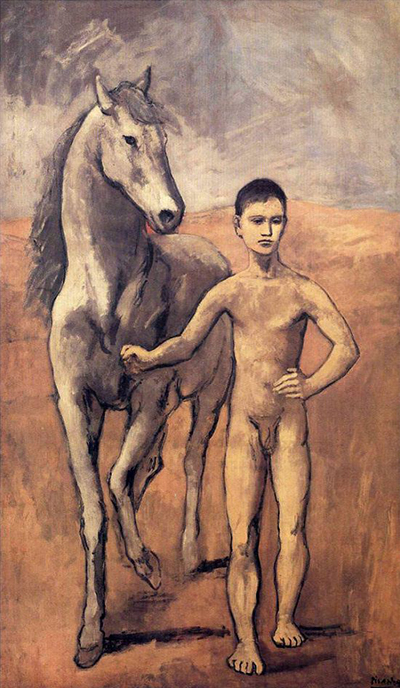It depicts a naked boy with his right arm gently outstretched, his right hand balled into a fist. Beside him, to his right, there walks a magnificent white horse.
Perhaps one of the first questions that arises in the viewer's mind is: is the boy truly leading the horse, or are these two beings not walking in harmony and in tandem?
The absence of any bridles or other trappings makes it clear that if the boy does have any power over the horse, his leadership comes not from crude instruments such as whips or leather tackle but rather from an innate strength.
Perhaps, it is up to the individual viewer to decide whether one of the figures is really leading the other, or whether they are to be seen as one.
Some art critics have even been tempted to see this painting as an allegorical one, which depicts the rule of the conscious mind over the passions, with the horse representing the passions and the upright boy beside it representing the ability of the mind to control the potentially turbulent power of the passions and to use them for good.
Boy Leading a Horse is a painting that is usually categorised as an Expressionist work of art, like many of Pablo Picasso's paintings. Expressionism was a significant artistic movement that began at the start of the 20th century in Germany and soon spread across the continent and (later) the world.
It is characterised by art works that depict a reality that is somehow augmented. Many Expressionist artists did so by using very vivid and dreamlike colours in their paintings (Kandinsky is one example of such a painter), whilst others did so by using bold, strong lines to create figures.
Picasso perhaps falls into the latter category when it comes to Boy Leading a Horse: the bold black lines of the outlines of the horse and its human companion definitely make them larger than life and make this a very Expressionist painting, though not an abstract one.
Picasso's fascination with the figure of the horse was a life long one. Horses appear in several of his other artworks. Perhaps the most well known example is the clearly pained and panicked horse in his epic, imposing artwork Guernica (currently on display in the Reina Sofia museum in Madrid, Spain).
Guernica was painted in June 1937, over 30 years after Boy Leading a Horse. Between 1906 and 1937 (the dates of Boy Leading a Horse and Guernica respectively), Picasso, sketched, sculpted and painted numerous other horses.
Another work of art that is particularly relevant to Boy Leading a Horse is a piece entitled 'Horse With a Youth In Blue': this oil on canvas work looks extremely similar to Boy Leading a Horse except this time the boy is clad in a blue shirt, a pair of simple trousers and shoes.
It might be argued that by clothing the human male figure this time around, Picasso removed much of his elemental power. Perhaps it is for this reason that viewers often prefer Boy Leading a Horse to the later version where the boy is clothed.
However it is approached and interpreted, however, it is clear that Boy Leading a Horse is a rich, profound work of art that can be seen to be allegorical or realistic - or both at once! It currently hangs in the Museum of Modern Art in New York, where many people come every year to see it in the flesh.
By the time that he died in 1973, Pablo Picasso (who was born in Malaga in Spain in 1881) was one of the most famous artists in the world.
He worked in clay, ink, paint and collage, to name but a few of the many media that he turned his hand to.

